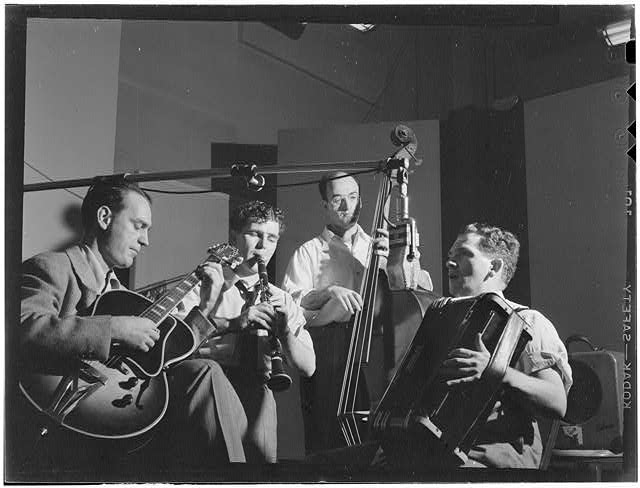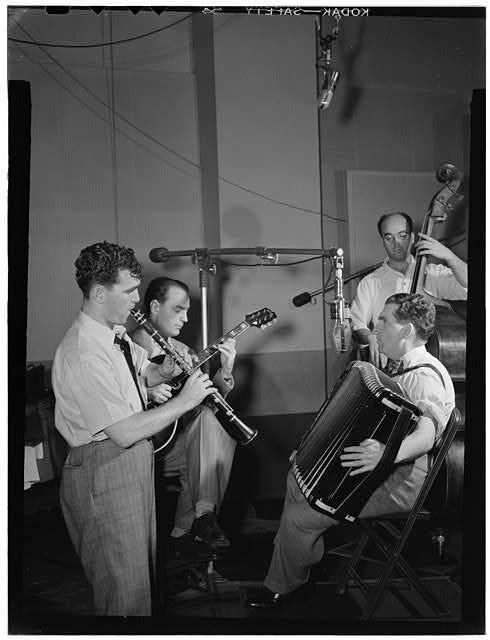 Of all the countless newspaper and magazine pieces that I’ve written over the years, one of the most immediately consequential was “Too Cool to Cash In, Favorite of the Few,” which appeared in the Sunday New York Times in 1997. It was a posthumous profile of the jazz musician Joe Mooney, who had a brief but potent vogue that I described in the opening paragraphs of the piece:
Of all the countless newspaper and magazine pieces that I’ve written over the years, one of the most immediately consequential was “Too Cool to Cash In, Favorite of the Few,” which appeared in the Sunday New York Times in 1997. It was a posthumous profile of the jazz musician Joe Mooney, who had a brief but potent vogue that I described in the opening paragraphs of the piece:
Time was when famous musicians spoke with awe of Joe Mooney, the blind jazz singer and accordionist from Paterson, N.J., who died in 1975. Frank Sinatra, not a man to toss around superlatives casually, called him “the best.”
By all rights, the object of such unstinting praise should have been famous himself, and for a little while he almost was. In 1946, Mooney and his quartet, who had been playing nightly in a Paterson bar and grill, lived out the small-time jazz musician’s wildest dream: they landed a recording contract with Decca and a weekly radio spot on ABC, were lauded in Time and The New Yorker, and began a 27-week run on 52d Street, where the likes of Sinatra, Duke Ellington and Johnny Mercer came to hear the quartet’s soft-spoken, crisply swinging brand of chamber jazz.
It was, alas, too good to be true, for the group that Down Beat magazine had called “the most exciting musical unit in the U.S. today” turned out to be too subtle to succeed commercially. Forced to break up the quartet, Mooney moved to Miami, where he spent the next decade and a half making music in comparative obscurity. “I can’t stand to be discovered one more time,” he told an admirer. Yet he returned to New York in 1963 to try his hand as a solo act, and the same thing happened all over again: star-spangled crowds, glowing reviews and a major-label recording contract, followed by total indifference from the public at large….
That, as I like to say, was a good day’s work. When I wrote this piece, none of the Mooney Quartet’s 78 recordings was available in any format. Thanks in large part to my well-placed prodding, all of them were transferred two years later to a pair of CDs, Do You Long for Oolong? and Joe Breaks the Ice, both which remain in print and can also be downloaded from iTunes. Around the same time, Mooney’s three solo LPs, Lush Life, The Happiness of Joe Mooney, and The Greatness of Joe Mooney, were reissued on CD, the second and third on a single-disc compilation. (I wrote the liner notes for most of these reissues.)
All of these recordings are wonderful, but it was and is the Mooney Quartet that I love best. As I explained in the Times:
The quartet consisted of Mooney on accordion, Andy Fitzgerald on clarinet, Jack Hotop on guitar and Gaetan (Gate) Frega on bass, an unorthodox lineup that produced some of the most distinctive sounds ever heard in small-group jazz. Not only could Mooney make his cumbersome instrument swing, he wrung from it pastel harmonies worthy of Art Tatum, and his intricate bop-flavored head arrangements made endlessly inventive use of Fitzgerald’s lithe upper-register playing, Hotop’s deft countermelodies and Mr. Frega’s springy bass lines.
Mooney sought to please both jazz lovers and ordinary listeners, playing everything from “Perdido” and “Prelude to a Kiss” to novelty tunes sung in unison by the quartet. Such group vocals had already been made popular by the King Cole Trio, but Mooney gave them a personal stamp by writing sly new original lyrics. (Here is his verse to “Meet Me at No Special Place”: You’re just as pretty as a picture/But wired for sound/If it wasn’t for your big fat mouth/You’d be fun to have around/Real great/I can hardly wait/I leave you with two words/Va-cate.) And though he was modest about his own singing, claiming that “I haven’t got a voice, just a delivery,” it was his gentle, wistful renderings of ballads like “September Song” and “They Say It’s Wonderful” that became the quartet’s trademark….
Part of what fascinated me about Mooney was the fact that he had come so close to success, close enough to be written up in a full-page story that ran in Time in 1948: “Bandsmen like Duke Ellington and players from other orchestras dropped in after hours to listen. Not since the wonderful first days of the Benny Goodman quartet had they heard the unit discipline that keeps all four men inside the same melodic scheme, yet leaves each musician free to create a succession of original and often exciting figures.”
Yet fame slipped through Mooney’s fingers, partly because his music was devoid of mass appeal and partly because he was a genuinely modest man who lacked the iron determination without which it is impossible to make a major career in the arts. I don’t doubt that he would have liked to be rich and famous, but it wasn’t in the cards, and once he finally realized that, he was content to retire to Florida and spend the rest of his life playing organ in local clubs (and at church each Sunday morning).
 I wasn’t the first person to try to spread the word about Joe Mooney. In 1989 Gunther Schuller wrote about the Mooney Quartet with great eloquence and penetration in The Swing Era, comparing the group to the Modern Jazz Quartet. Bucky and John Pizzarelli have both performed and recorded his songs. More recently, Tony Bennett spoke warmly of Mooney in his autobiography. But the brief revival of interest in Mooney’s work that was triggered by my New York Times article has long since dissipated, and he is scarcely better known today than he was in 1989–or 1949, for that matter.
I wasn’t the first person to try to spread the word about Joe Mooney. In 1989 Gunther Schuller wrote about the Mooney Quartet with great eloquence and penetration in The Swing Era, comparing the group to the Modern Jazz Quartet. Bucky and John Pizzarelli have both performed and recorded his songs. More recently, Tony Bennett spoke warmly of Mooney in his autobiography. But the brief revival of interest in Mooney’s work that was triggered by my New York Times article has long since dissipated, and he is scarcely better known today than he was in 1989–or 1949, for that matter.
Mr. JazzWax, who discovered Mooney as a result of my efforts, wrote about him last week in a pair of postings that tell the story of his later career. I commend these excellent postings to your attention. As for the records, I urge you to give them a listen. Mooney isn’t for everyone–that was his problem–but if he’s for you, you’ll know it at once.
* * *
The photographs of the Joe Mooney Quartet reproduced above were taken by Bill Gottlieb at a 1946 Decca recording session. To see other Gottlieb photographs of Mooney and his musicians, go here.
